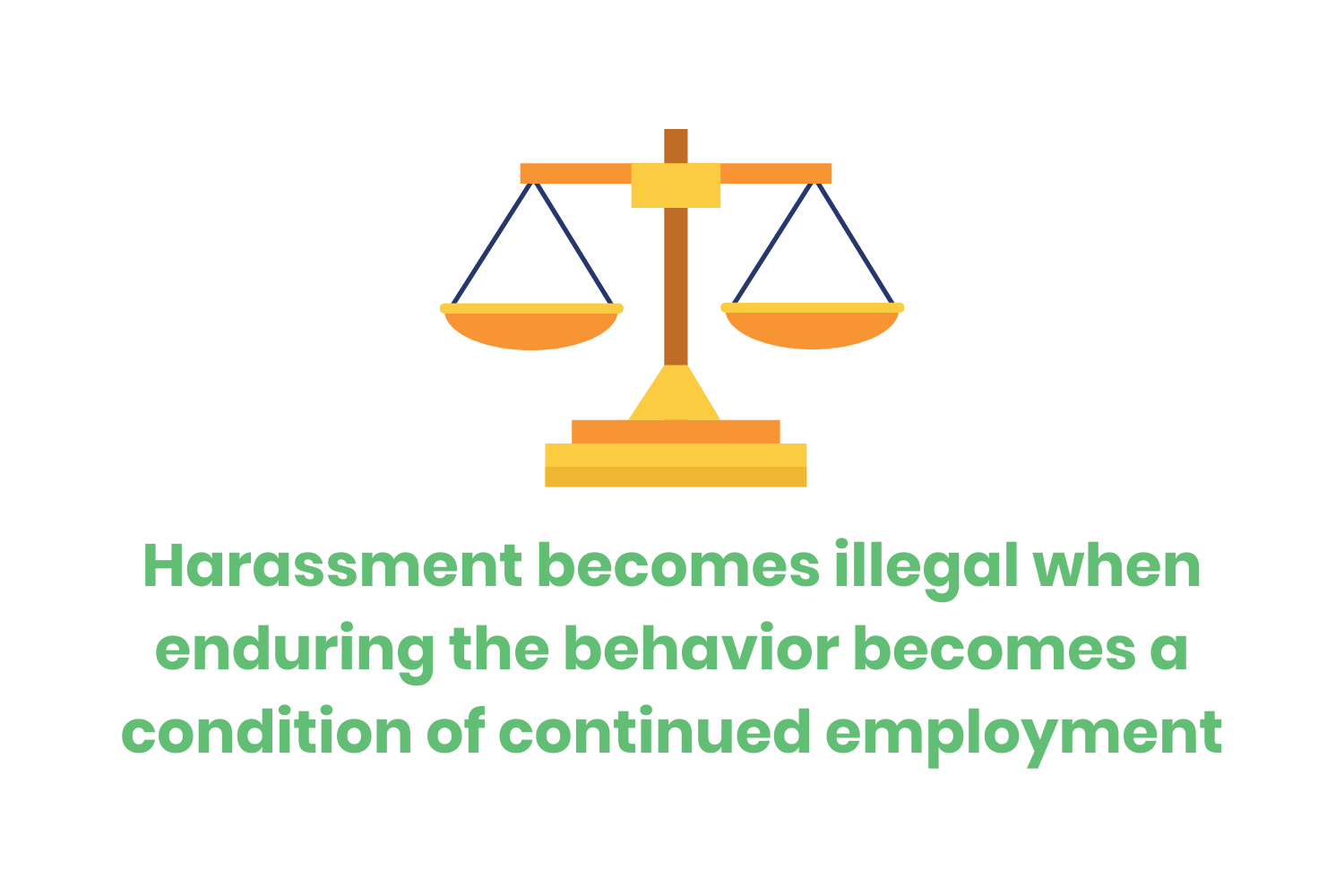According to constitutional law, the legal definition of a hostile work environment is…
Any situation where an employer imposes or allows the imposition of an environment of steady and pernicious hostility to an employee. This hostility occurs concerning protected categories so that a reasonable person would be unable to continue working under those conditions.
Several laws in the United States prevent hostile work environments from occurring. The U.S. The Equal Employment Opportunity Commission (EEOC) is responsible for enforcing such laws, including…
Title VII of the Civil Rights Act of 1964
The Age Discrimination in Employment Act of 1967 (ADEA)
The Americans with Disabilities Act of 1990 (ADA)
Occupational Safety and Health Act (OSHA)
Sarbanes-Oxley Act
Family and Medical Leave Act (FMLA)
These laws make it illegal to harass and abuse someone in the workplace, especially if the actions are pervasive enough to create an intimidating environment. Aggression, passive aggression, and abuse are all forms of harassment.
These acts become illegal when enduring such behavior becomes a condition of continued employment. It also becomes illegal when the conduct is severe or pervasive enough that any reasonable person would agree that the workplace is intimidating, hostile, or abusive.
All of the anti-discrimination laws prohibit retaliation. Both managers and employees must understand what retaliation is, what it looks like, why people retaliate, and what you can do about this illegal conduct.
Table of Contents
What is Retaliation?
According to the Cambridge Dictionary, retaliation is the act of hurting someone because of something they did or said. It’s also the act of doing something harmful to a person because of what they did or said to retaliate.
The law agrees with this definition.
The EEOC enforces laws designed to prohibit employers from punishing job applicants or employees for protesting hostile work environments. This includes harassment and discrimination.
These rights are “protected activities”. Asserting these rights is legal through EEO laws and doing so can take many forms.
It’s unlawful to retaliate against job applicants or employees for…
Being a witness in an EEOC charge, complaint, investigation, or lawsuit
Communicating with a supervisor or manager about employment discrimination
This includes harassment
Answering questions during an investigation of alleged harassment
This includes government and employer investigations
Refusing to follow orders that would create a hostile work environment
Resisting sexual advances
Intervening to protect someone from sexual advances
Requesting accommodations for a disability
Requesting accommodations for religion
Asking managers or co-workers about salary information to uncover potentially discriminatory wages
How To Identify Retaliation Against You
Sometimes, it’s fairly obvious that an employer retaliates against an employee. For example, people would raise an eyebrow if a company fires an employee after said employee files a harassment complaint.
However, many signs of harassment aren’t so obvious. Examples of this include…
Reprimanding an employee
Giving an employee a performance evaluation lower than it should be
Transferring an employee to a less desirable position
Engaging in verbal abuse
Engaging in physical abuse
Threatening to make reports to authorities
For example, threatening to report an employee’s immigration status or contacting the police
Making reports to authorities
Increasing scrutiny
Spreading false rumors
Treating a family member poorly
For example, canceling a contract with someone’s spouse
Making the employee’s work more difficult
For example, punishing an employee for an EEOC complaint by purposefully changing their work schedule to conflict with family responsibilities
Examples of Retaliation
Retaliation happens when a manager, supervisor, administrator, executive, or employer takes any form of adverse action against an employee for engaging in protected activity.
In this context, an adverse action is an action that would dissuade a reasonable person from voicing their concerns about a possible violation related to protected activities.
Below are some examples of retaliation.
Example 1: Joe
Joe is a chef at a restaurant who works both lunch and dinner shifts during the week. He contacts a law firm confidentially to discuss the laws concerning overtime pay. Joe discloses the overtime information to a fellow cook, saying how all of the employees should earn extra pay for overtime hours worked. However, the restaurant manager overhears the conversation and fires Joe.
In this example, the company terminated Joe for contacting the law firm. This is retaliation from the employer against protected actions, violating the law.
Example 2: MIA
Mia requested time off, a right protected by the Family and Medical Leave Act, from her job as a hotel desk clerk. She requested time off because she started to suffer from migraine headaches making it impossible to work. Her boss approved her request. Mia used three days of leave in March and one day in April. In August, Mia had another migraine. She had to take leave for another two days. After returning to work, Mia discovered her new manager reduced her schedule from 40 hours to 20 hours a week. The manager said that the company needed workers who would show up every day.
In this example, Mia’s boss reduced her hours because she exercised her right to FMLA. This is retaliation. Laws prohibit this kind of conduct and it's an FMLA violation.
Example 3: Olivia
Olivia works at a call center while taking care of her newborn. She uses her lunch break to feed her child but needs extra time to finish pumping before she can return to work. When she’s late returning from lunch, her boss scolds her. Olivia’s supervisor tells her that she cannot use any more time for “personal time”. When Olivia asks to take another break for pumping later that day, her boss sends her home for the rest of the day without pay.
In this example, the supervisor sent Olivia home for attempting to exercise her FMLA rights. This retaliation and FMLA violation are illegal.
Example 4: Fred
An anonymous farm participated in the H-2A visa program. At this farm, Fred and other workers with H-2A visas asked the employer for food and water. The farm hadn’t provided such necessities for employees. When asked for water and food, the farm’s management became angry and threatened physical harm to the staff.
In this example, the farm denied Fred food and water. They proceeded to threaten Fred with physical harm. All of these actions are forms of retaliation and violate worker rights.
Why Do Managers Retaliate?
Legally, it doesn’t matter why people retaliate against whistleblowers. The law concerns itself with the act of retaliation. Lawyers care if an employer engaged in unlawful behavior.
To truly understand how this happens, we have to look at behavioral science. Behavioral science focuses on retaliation as an intrapersonal and interpersonal experience. This encompasses the subjective definitions of “harm” and “offense”. The act of retaliation is a mechanism people use to address transgression.
With this said, it’s important to understand why people retaliate from the human perspective.
Human psychology says that the act of retaliation is on par with revenge. If a person perceives that their treatment is unfair, they may retaliate in an attempt to restore equilibrium by taking the matter into their own hands.
Retaliation begins with a perceived offense. For example, someone may think you initiated a discrimination claim. If the alleged perpetrator truly believes they did nothing wrong, they may begin to desire revenge and retaliate.
This is also true if the alleged perpetrator believes that the offense was somehow justified. When this happens, retaliation becomes a way of alleviating psychological discomfort, or a coping mechanism, associated with perceived injustice.
Research shows that wanting to retaliate is common when experiencing an offensive interpersonal encounter. This is especially true if the situation threatens the retaliator's self-image.
The desire to retaliate is quite common. However, acting on this desire is not too common since doing so has a high chance of backfiring.
What Can You Do About Retaliation as an Employee?
Even if the law is on your side, you might not know what to do about a hostile work environment and retaliation. A good first step is to talk to your supervisor or boss. However, if your boss is the one retaliating, you can also talk with your company’s human resources department.
Your employer might have a perfectly reasonable, legal, and legitimate explanation for the situation. Maybe your job is now during the day shift because there was an opening. Maybe you faced a demotion because of several documented performance issues. Both of these situations are legal changes to your work environment. If they happened around the same time you complained about harassment, it could just be a coincidence.
However, if your employer cannot give you a legitimate explanation, you should voice your concerns about retaliation. Naturally, the company will deny it. Sometimes employers retaliate without realizing it. By voicing concerns about the negative actions taking place only after you filed a complaint, you can give the company a chance to correct the situation.
If you suspect retaliation and your employer won’t do anything about it, you need to collect evidence. Put on your detective hat and collect evidence that there is a correlation between the behavior that you believe triggered the retaliation and the company’s retaliatory behavior. The more information and proof you collect, the stronger your argument will be in court.
To collect evidence, you need to document the alleged retaliatory behavior. Keep track of historical information before the incident that you believe triggered the retaliation. For example, go through your email and other documents to show inconsistencies in opinion before the complaint and after the complaint.
In the worst-case scenario, you need to consult with a lawyer. If the company fired you or if you lost a significant amount of wages due to retaliation, you must involve the law to correct the situation. A lawyer can tell you about the strength of your case, help collect evidence, inform you of potential compensation from the lawsuit, and more.
What Can You Do About Retaliation as a Manager?
It's hard not to take an EEO allegation personally. Managers accused of retaliation need to take a step back from the situation to evaluate what happened and consider the employee’s reactions.
Someone can interpret a negative change in behavior after an EEOC allegation as retaliatory.
Therefore it’s important to carefully evaluate your actions as a manager. To prevent perceived or actual retaliatory behavior managers should…
Avoid publicly discussing the allegation(s)
Don’t share information about investigation activities with any other managers or subordinates
Don’t share information about EEOC activity regarding the allegation(s)
Be mindful not to isolate any employees
Avoid reactive behavior
This includes denying the employee information, equipment, and/or benefits provided to others performing similar tasks.
Don’t interfere with the EEOC process
Provide clear and accurate information to EEOC and law officials
This includes staff, the investigator, and the Judge
Don’t threaten the employee
Don’t threaten the witness
Don’t threaten anyone else involved in the processing of a complaint
Conclusion
Retaliation in the workplace is a complicated mess. It can happen in a variety of ways for numerous reasons.
If you find yourself dealing with retaliation, you need to say something. Make sure to document everything that happened and create an accurate timeline of events. If you can’t turn to your boss for help, try turning to HR. If the company still doesn’t alleviate the situation, you always have the option of contacting a lawyer.
The best way to deal with retaliation is to stop the hostile environment from happening in the first place. Anti-harassment training is the best way to curb incidents of retaliation in the workplace.















